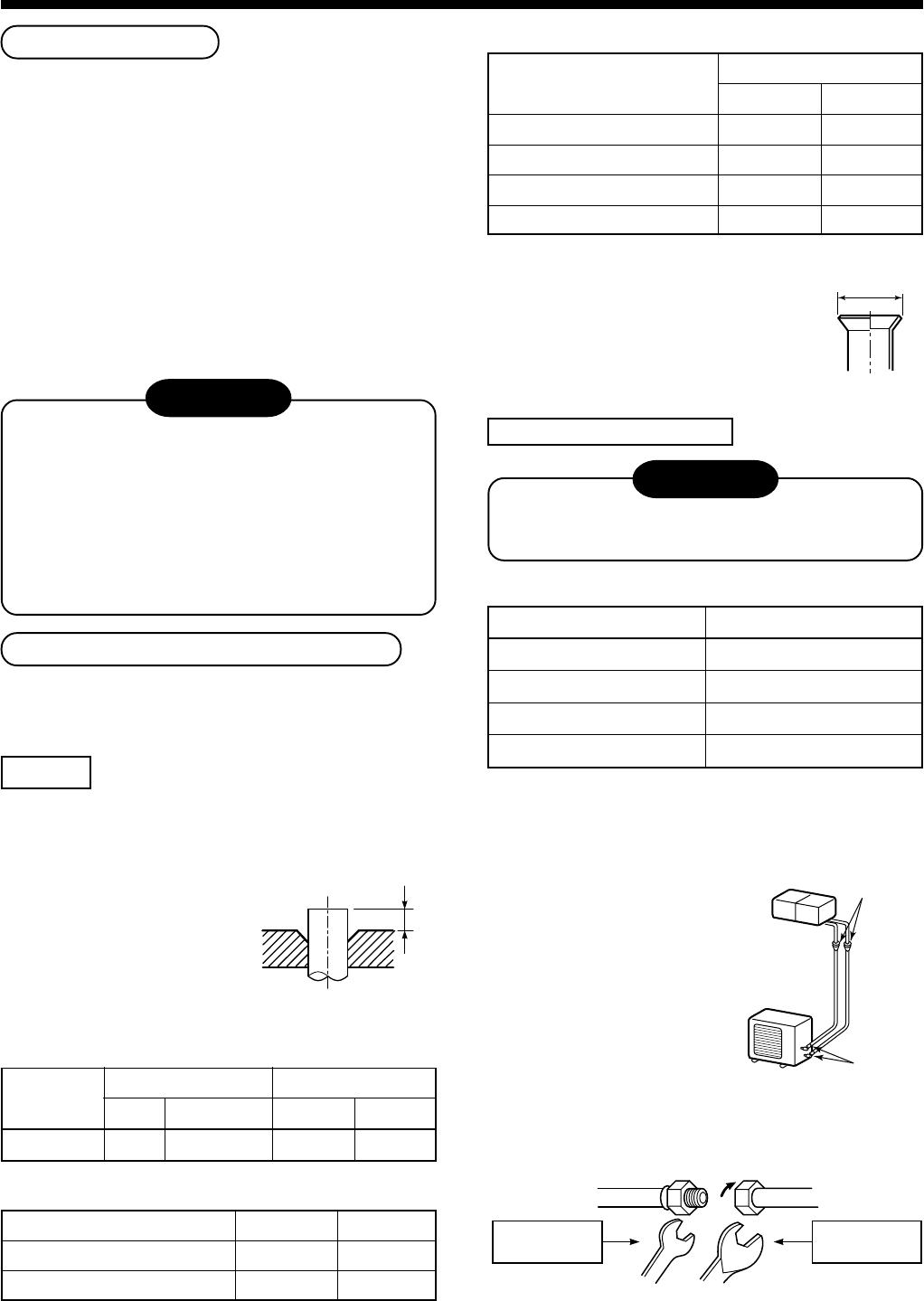
– 84 –
RAV-SP1100UT-E,
RAV-SM560UT-E, RAV-SM800UT-E, RAV-SM1100UT-E, RAV-SM1400UT-E
4
REFRIGERANT PIPING AND EVACUATING
Refrigerant Piping
1. If the outdoor units are to be mounted on a wall,
make sure that the supporting platform is
sufficiently strong. The platform should be
designed and manufactured to maintain its strength
over a long period of time, and sufficient
consideration should be given to ensuring that the
outdoor unit will not fall.
2. Use copper pipe with 0.8 mm or more thickness.
(In case pipe size is Ø15.9, with 1.0mm or more.)
3. Flare nut and flare works are also different from
those of the conventional refrigerant.
Take out the flare nut attached to the main unit of
the air conditioner, and use it.
CAUTION
IMPORTANT 4 POINTS FOR PIPING WORK
1. Remove dust and moisture from the inside of
the connecting pipes.
2. Tight connection (between pipes and unit)
3. Evacuate the air in the connecting pipes using
VACUUM PUMP.
4. Check the gas leakage. (Connected points)
Permissible Piping Length and Heat
They vary according to the outdoor unit. For details,
refer to the Installation Manual attached to the outdoor
unit.
Flaring
Insert a flare nut into the pipe, and flare the pipe.
As the flaring sizes of R410A differ from those of
refrigerant R22, the flare tools newly manufactured for
R410A are recommended.
However, the conventional
tools can be used by
adjusting projection
margin of the copper pipe.
+0
-
0.4
B
A
Imperial (Wing nut type)
• Flaring diam. meter size : A (Unit : mm)
*
In case of flaring for R410A with the conventional
flare tool, pull it out approx.
0.5 mm more than that for R22 to
adjust to the specified flare size.
The copper pipe gauge is useful
for adjusting projection margin size.
Tightening connection
CAUTION
• Do not apply excessive torque. Otherwise, the
nut may crack depending on the conditions.
(Unit : N•m)
• Tightening torque of flare pipe connections
Pressure of R410A is higher than that of R22.
(Approx. 1.6 times) Therefore, using a torque
wrench, tighten the flare pipe connecting sections
which connect the indoor
and outdoor units of the
specified tightening torque.
Incorrect connections may
cause not only a gas
leak, but also a trouble
of the refrigeration cycle.
Align the centers of the connecting pipes and tighten
the flare nut as far as possible with your fingers. Then
tighten the nut with a spanner and torque wrench as
shown in the figure.
Flare at
indoor
unit side
Flare at
outdoor
unit side
Half union
Flare nut
Externally
threaded side
Internally
threaded side
Use a wrench to secure.
Use a torque wrench to tighten.
Outer diam. of
copper pipe
6.4 to 15.9
R410A tool used
R410A R22
0 to 0.5 (Same as left)
Conventional tool used
R410A R22
1.0 to 1.5 0.5 to 1.0
Outer diam. of copper pipe
6.4 or 9.5
12.7 or 15.9
R410A R22
1.5 to 2.0 1.0 to 1.5
2.0 to 2.5 1.5 to 2.0
Outer diam. of copper pipe
6.4
9.5
12.7
15.9
A
R410A R22
9.1 9.0
13.2 13.0
16.6 16.2
19.7 19.2
Outer diam. of copper pipe
6.4 mm (diam.)
9.5 mm (diam.)
12.7 mm (diam.)
15.9 mm (diam.)
Tightening torque
14 to 18 (1.4 to 1.8 kgf•m)
33 to 42 (3.3 to 4.2 kgf•m)
50 to 62 (5.0 to 6.2 kgf•m)
68 to 82 (6.8 to 8.2 kgf•m)
• Projection margin in flaring : B (Unit : mm)
Rigid (Clutch type)


















